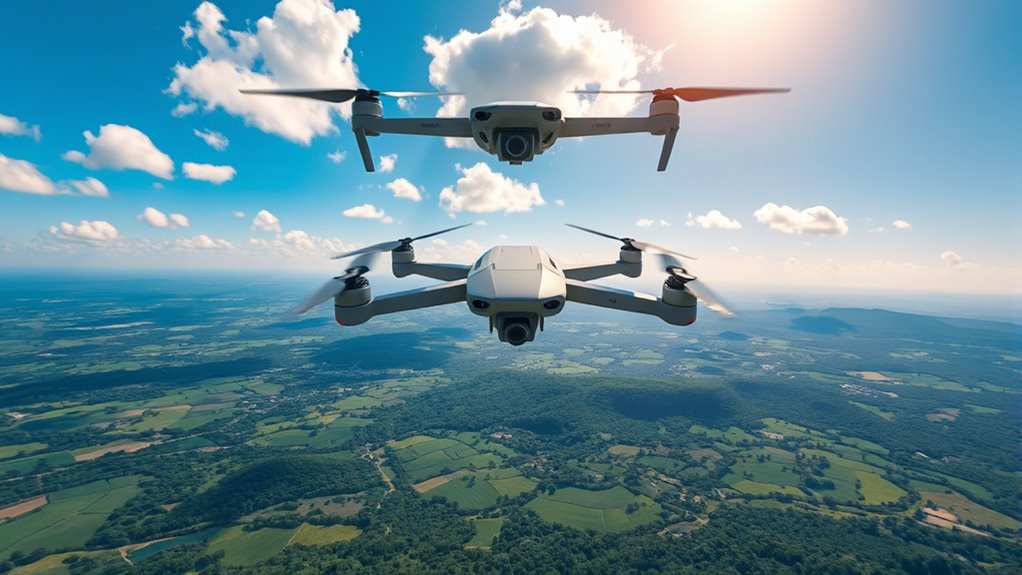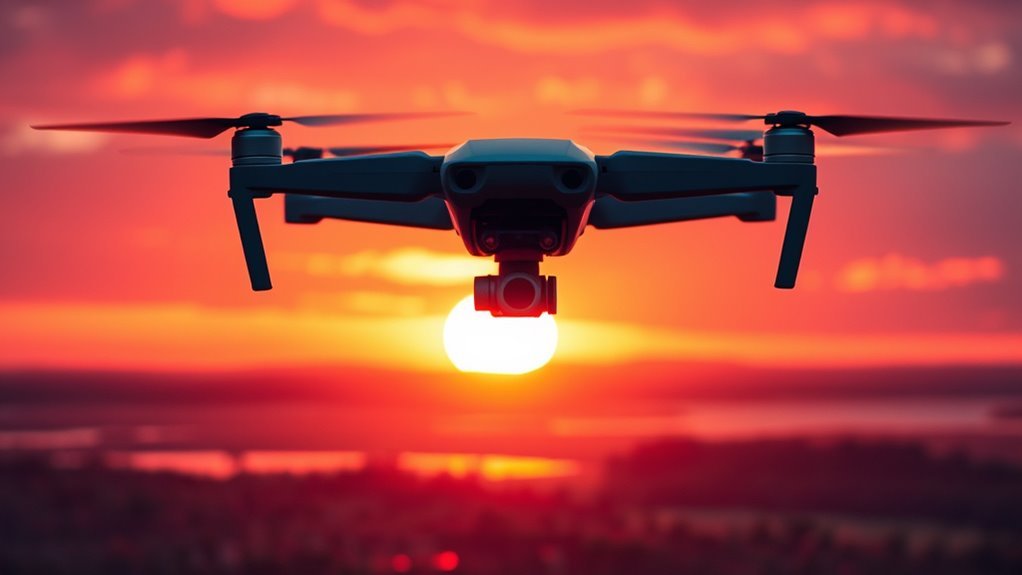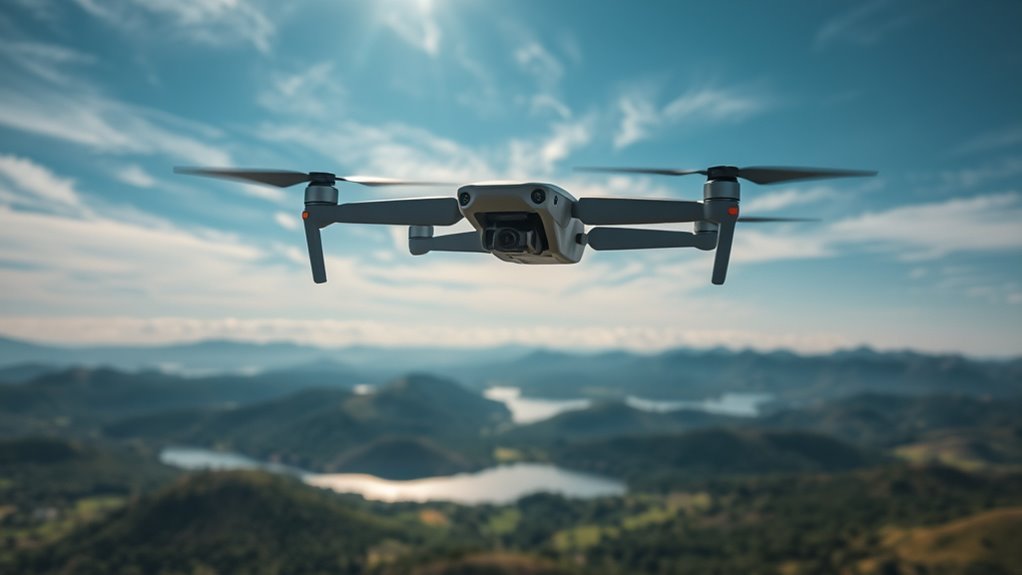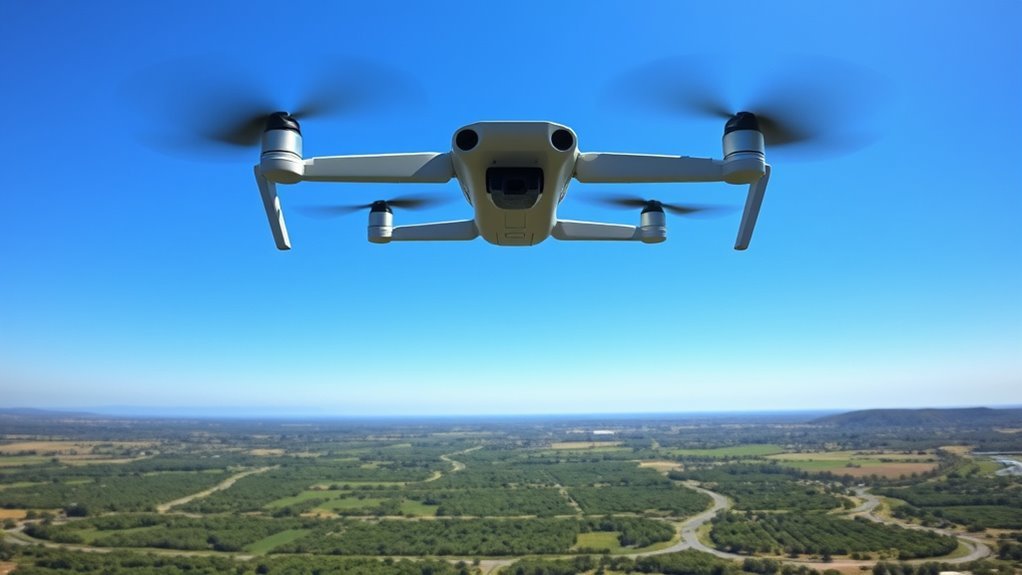Headless mode in drones simplifies control by aligning the drone’s movements with your perspective, regardless of its orientation. This mode uses advanced algorithms to track its initial direction, allowing for intuitive navigation. As a result, you won’t need to constantly adjust to the drone’s facing, making it ideal for beginners and enhancing maneuverability. This reduces cognitive load and lets you focus on creative flying. Explore the nuances of headless mode to maximize your piloting skills.
Understanding Headless Mode

Understanding Headless Mode in drones is essential for both novice and experienced pilots, especially since it simplifies navigation. This mode effectively eliminates the need to orient the drone in relation to its pilot’s position, allowing you to control it based on your perspective. One of the key headless advantages is enhanced maneuverability; you can focus on your flying skills without worrying about the drone’s orientation. Headless applications include aerial photography and racing, where quick directional changes are vital. By utilizing headless mode, you gain the freedom to explore complex environments with minimal cognitive load. This feature empowers you to execute sophisticated maneuvers, maximizing your drone’s potential while minimizing the risk of disorientation. Embracing headless mode can greatly enhance your flying experience.
How Headless Mode Works

Headless mode operates by altering the drone’s control system to disregard its physical orientation relative to the pilot. This means that no matter which way the drone is facing, forward, backward, left, and right commands remain consistent from your perspective. The headless mode mechanics utilize advanced control algorithms that track the drone’s initial direction and adjust the commands accordingly.
Here’s a quick overview of the differences between standard and headless mode:
| Standard Mode | Headless Mode |
|---|---|
| Orientation matters | Orientation disregarded |
| Moves based on facing | Moves based on pilot view |
| Complex navigation | Simplified navigation |
Benefits of Using Headless Mode

Using headless mode simplifies control, particularly for beginners who may struggle with orientation. This feature enhances awareness of the drone’s position relative to the pilot, allowing for more intuitive flight. Additionally, it improves maneuverability, enabling precise movements regardless of the drone’s facing direction.
Simplified Control for Beginners
For novice drone pilots, headless mode offers a remarkable simplification of control that greatly enhances the flying experience. This user-friendly feature eliminates the complexity of orientation, allowing you to focus on intuitive flying. In headless mode, the drone responds relative to your position, meaning forward is always in the direction you’re facing, regardless of the drone’s orientation. This eliminates confusion, particularly for those unfamiliar with traditional controls. You can freely explore your surroundings without the anxiety of losing track of the drone’s front. As a result, headless mode empowers you, enabling you to build confidence and develop flying skills more quickly. Ultimately, this feature transforms your initial flights into enjoyable, liberating experiences, making drone piloting accessible and less intimidating.
Enhanced Orientation Awareness
While many drone features enhance flying efficiency, the ability to maintain orientation awareness in headless mode stands out as a significant advantage. This mode simplifies your flying experience by allowing you to control the drone based on its relation to your position rather than its front-facing direction. You’ll gain enhanced spatial awareness, making it easier to navigate complex environments without losing track of the drone’s position. This intuitive flight experience reduces cognitive load, letting you focus more on capturing stunning aerial footage or exploring new terrains. By eliminating the need to constantly adjust for the drone’s orientation, you can enjoy a more fluid and liberated flying experience, ultimately increasing your confidence and enjoyment during flight sessions.
Improved Maneuverability in Flight
Headless mode considerably enhances maneuverability in flight, allowing pilots to execute complex movements with greater precision. This mode simplifies control, making it easier for you to navigate your drone regardless of its orientation. With headless mode activated, your drone’s response is based solely on the remote control’s direction, which markedly boosts aerial agility. You can perform intricate maneuvers without needing to recalibrate your understanding of the drone’s position. This heightened flight precision empowers you to focus on creativity and exploration, rather than orientation challenges. By reducing the cognitive load associated with directional changes, headless mode facilitates a more fluid flying experience, giving you the freedom to push the limits of your drone’s capabilities.
Who Can Benefit From Headless Mode?
Headless mode is particularly advantageous for beginners learning to fly drones, as it simplifies control and reduces the learning curve. By eliminating the need to orient the drone based on its front, it aids navigation and allows for more intuitive maneuvers. This feature fosters confidence in new pilots, enabling them to focus on mastering flight techniques without the added complexity of directional awareness.
Beginners Learning to Fly
As you commence on your journey to learn how to fly a drone, understanding the advantages of headless mode can greatly enhance your experience. This feature is especially beneficial for beginners, as it simplifies control and guarantees drone safety. Here are some beginner tips to take into account:
- Orientation Control: Flying becomes intuitive, as the drone moves in the direction of your stick input, regardless of its front.
- Reduced Stress: You can focus on flying without worrying about the drone’s orientation.
- Quick Learning Curve: You’ll grasp basic flying techniques faster, boosting your confidence.
- Enhanced Maneuverability: It allows for easier navigation in tight spaces.
Aiding Navigation and Control
For those venturing beyond the initial stages of drone operation, headless mode continues to prove advantageous. This mode simplifies navigation challenges, especially in complex environments. When the drone shifts orientation, headless mode aligns your commands with the drone’s current direction, ensuring consistent responsiveness.
Advanced users who seek to explore various terrains or intricate aerial maneuvers will find that headless mode enhances control systems, allowing for more intuitive flight experiences. It enables you to focus on capturing stunning aerial footage or conducting inspections without the distraction of constantly recalibrating your directional inputs.
This feature not only fosters greater confidence in your piloting skills but also empowers you to fully enjoy the freedom and creativity that flying a drone offers.
Differences Between Headless Mode and Normal Mode
While both headless mode and normal mode serve to control a drone, they fundamentally differ in how they interpret the pilot’s commands. Understanding these differences can enhance your flying experience.
- Headless Mode Advantages: Simplifies control by aligning movements with the pilot’s perspective.
- Normal Mode Challenges: Requires constant awareness of the drone’s orientation, complicating maneuvers.
- Directional Control: In headless mode, forward is always away from you, regardless of the drone’s facing.
- Learning Curve: New pilots often find headless mode more intuitive, reducing the difficulty of mastering flight.
Common Misconceptions About Headless Mode
Many pilots mistakenly believe that headless mode eliminates the need for spatial awareness entirely, which can lead to unexpected challenges during flight. This misunderstanding stems from various headless mode misconceptions and flight control myths. While headless mode simplifies orientation, it doesn’t negate the importance of understanding your drone’s position relative to its surroundings.
| Misconception | Reality |
|---|---|
| No need for spatial awareness | Awareness is still essential |
| It’s foolproof for beginners | Mistakes can still happen |
| It works in all conditions | Environmental factors affect performance |
| Directional controls are irrelevant | Control still depends on pilot input |
| It’s only for beginners | Experienced pilots can benefit too |
Understanding these points can enhance your flying experience and help you maximize the advantages of headless mode.
Tips for Using Headless Mode Effectively
To effectively utilize headless mode, you should first confirm that your drone is properly calibrated before each flight. This guarantees accurate orientation and maximizes headless advantages. Here are some tips to prevent common mistakes:
Ensure your drone is calibrated before each flight to maximize the benefits of headless mode and maintain accurate orientation.
- Always fly in an open area to avoid obstacles that can confuse the drone’s orientation.
- Familiarize yourself with the controls in normal mode before switching to headless mode.
- Maintain a consistent height to improve your spatial awareness and control.
- Practice returning to your takeoff point, as this helps reinforce directional understanding.
Limitations of Headless Mode
Though headless mode simplifies navigation for novice pilots, it comes with significant limitations that can hinder performance. One major drawback is the potential for disorientation when the drone experiences loss of signal or battery failure. Additionally, headless mode can lead to navigation challenges in complex environments, where obstacles may cause confusion.
| Limitation | Description |
|---|---|
| Disorientation | Loss of reference can lead to unintended movements. |
| Obstacle Navigation | Difficulty in maneuvering around complex structures. |
| Limited Range of Control | Less effective wind resistance compared to normal mode. |
| Battery Dependency | Reliance on battery life for headless functionality. |
Understanding these limitations of headless mode helps you make informed decisions while flying, ensuring a safer and more enjoyable experience.
Future of Headless Mode in Drone Technology
The future of headless mode in drone technology is poised for significant advancements, driven by innovations in navigation systems and artificial intelligence. As these technological advancements unfold, you’ll see a variety of future applications enhancing your flying experience:
- Enhanced GPS Accuracy: Improved positioning systems for better navigation.
- AI-Driven Flight Path Optimization: Intelligent algorithms that adapt to environmental conditions, leading to greater flight efficiency and optimized routes.
- User-Centric Interfaces: Simplified controls for novice and expert pilots alike.
- Safety Features: Advanced collision avoidance systems for safer operations.
These enhancements promise to make headless mode not just a convenience but an essential feature, empowering you to explore your surroundings with unprecedented freedom and confidence. As the technology evolves, expect headless mode to redefine how you interact with drones. Additionally, AI will play a crucial role in real-time obstacle detection, ensuring safer flights and reducing the likelihood of accidents.
Frequently Asked Questions
Does Headless Mode Work in All Drone Models?
Like a chameleon blending into its surroundings, headless mode doesn’t work universally across all drone models. Compatibility issues arise from model differences, making it essential to check specifications before expecting uniform functionality in every drone.
Can Headless Mode Be Turned off During Flight?
Yes, you can turn off headless mode during flight, but be aware of its advantages, like ease of control, and limitations, such as potential disorientation. Make certain you’re comfortable with standard controls before shifting modes.
How Does Headless Mode Affect Battery Life?
Headless mode can increase battery consumption due to the additional processing required for orientation adjustments. This may reduce your flight duration, especially in complex maneuvers, so consider using it judiciously to maximize your drone’s performance.
Is Headless Mode Suitable for Indoor Flying?
Headless mode can enhance indoor navigation by simplifying orientation, but its effectiveness varies. You’ll enjoy increased flying stability, allowing for smoother maneuvers, yet it’s essential to practice before attempting advanced indoor flight techniques.
Can Headless Mode Help Beginners Learn to Fly Drones?
Imagine sailing a ship without worrying about the wind’s direction; that’s what headless mode offers beginners. It boosts flight confidence and provides essential beginner benefits, allowing you to focus on mastering maneuvering without disorientation.

